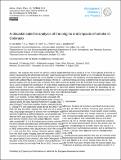A decadal satellite analysis of the origins and impacts of smoke in Colorado
Author(s)
Val Martin, M.; Ford, B.; Prenni, A. J.; Wiedinmyer, C.; Heald, Colette L.
DownloadMartin-2013-A decadal satellite.pdf (2.631Mb)
PUBLISHER_CC
Publisher with Creative Commons License
Creative Commons Attribution
Terms of use
Metadata
Show full item recordAbstract
We analyze the record of aerosol optical depth (AOD) measured by the MODerate resolution Imaging Spectroradiometer (MODIS) aboard the Terra satellite in combination with surface PM[subscript 2.5] to investigate the impact of fires on aerosol loading and air quality over Colorado from 2000 to 2012, and to evaluate the contribution of local versus transported smoke. Fire smoke contributed significantly to the AOD levels observed over Colorado. During the worst fire seasons of 2002 and 2012, average MODIS AOD over the Colorado Front Range corridor were 20–50% larger than the other 11 yr studied. Surface PM[subscript 2.5] was also unusually elevated during fire events and concentrations were in many occasions above the daily National Ambient Air Quality Standard (35 μg m[superscript −3]) and even reached locally unhealthy levels (> 100 μg m[superscript −3]) over populated areas during the 2012 High Park fire and the 2002 Hayman fire. Over the 13 yr examined, long-range transport of smoke from northwestern US and even California (> 1500 km distance) occurred often and affected AOD and surface PM[subscript 2.5]. During most of the transport events, MODIS AOD and surface PM[subscript 2.5] were reasonable correlated (r[superscript 2] = 0.2–0.9), indicating that smoke subsided into the Colorado boundary layer and reached surface levels. However, that is not always the case since at least one event of AOD enhancement was disconnected from the surface (r[superscript 2]<0.01 and low PM[subscript 2.5] levels). Observed plume heights from the Multi-angle Imaging SpectroRadiometer (MISR) satellite instrument and vertical aerosol profiles measured by the space-based Cloud-Aerosol LIdar with Orthogonal Polarization (CALIOP) showed a complex vertical distribution of smoke emitted by the High Park fire in 2012. Smoke was detected from a range of 1.5 to 7.5 km altitude at the fire origin and from ground levels to 12.3 km altitude far away from the source. The variability of smoke altitude as well as the local meteorology were key in determining the aerosol loading and air quality over the Colorado Front Range region. Our results underline the importance of accurate characterization of the vertical distribution of smoke for estimating the air quality degradation associated with fire activity and its link to human health.
Date issued
2013-08Department
Massachusetts Institute of Technology. Department of Civil and Environmental Engineering; Massachusetts Institute of Technology. Department of Earth, Atmospheric, and Planetary SciencesJournal
Atmospheric Chemistry and Physics
Publisher
Copernicus GmbH
Citation
Val Martin, M., C. L. Heald, B. Ford, A. J. Prenni, and C. Wiedinmyer. “A decadal satellite analysis of the origins and impacts of smoke in Colorado.” Atmospheric Chemistry and Physics 13, no. 15 (August 2, 2013): 7429-7439.
Version: Final published version
ISSN
1680-7324
1680-7316